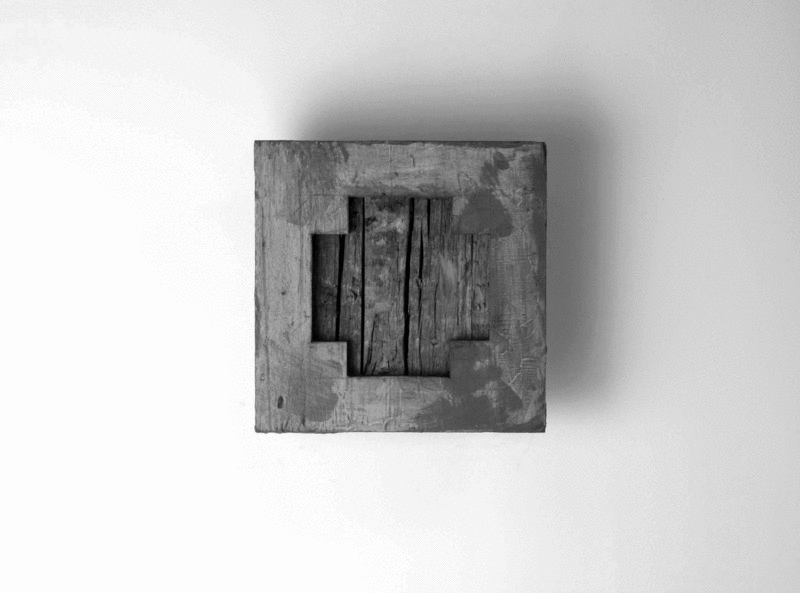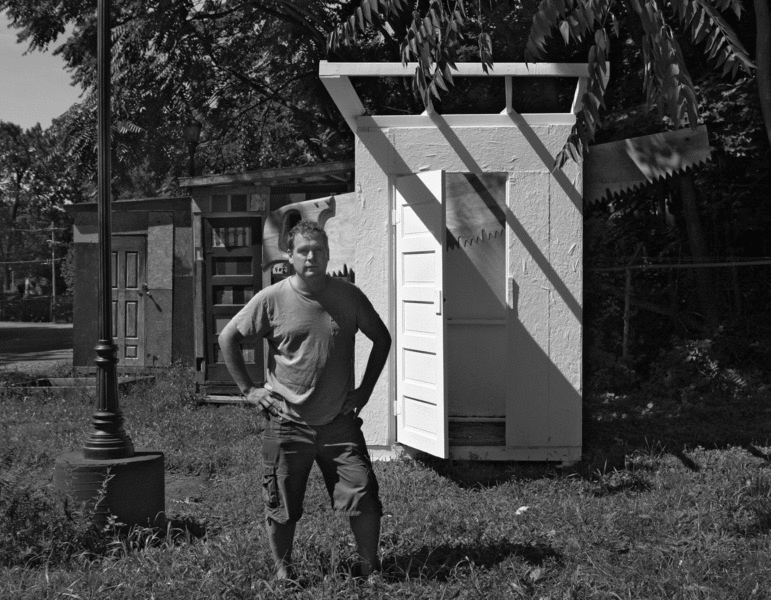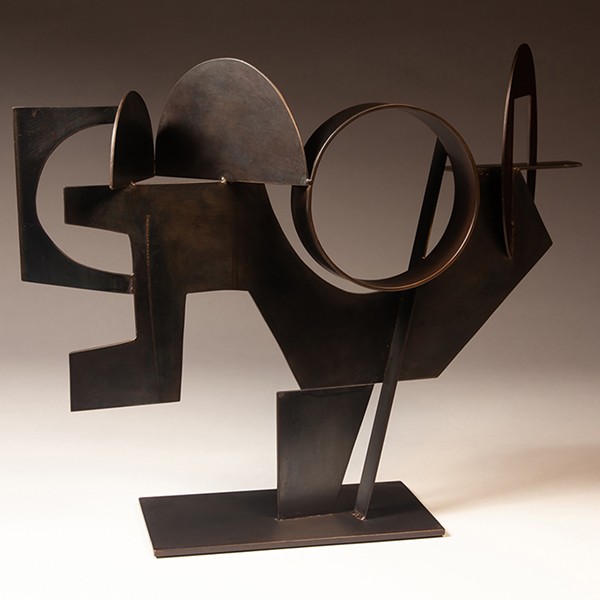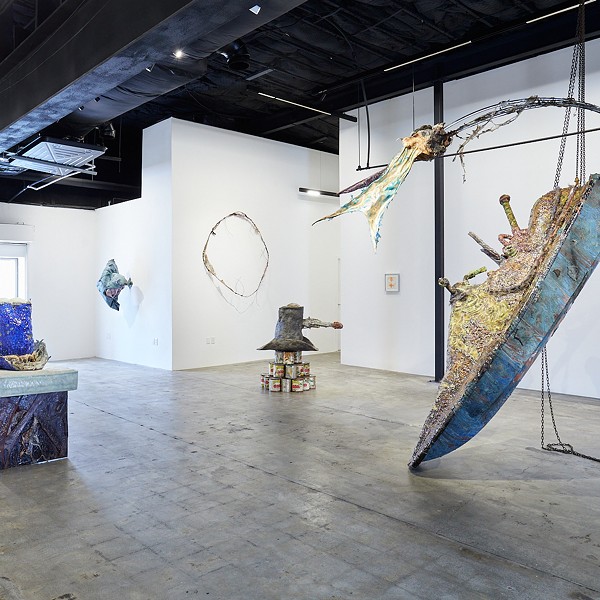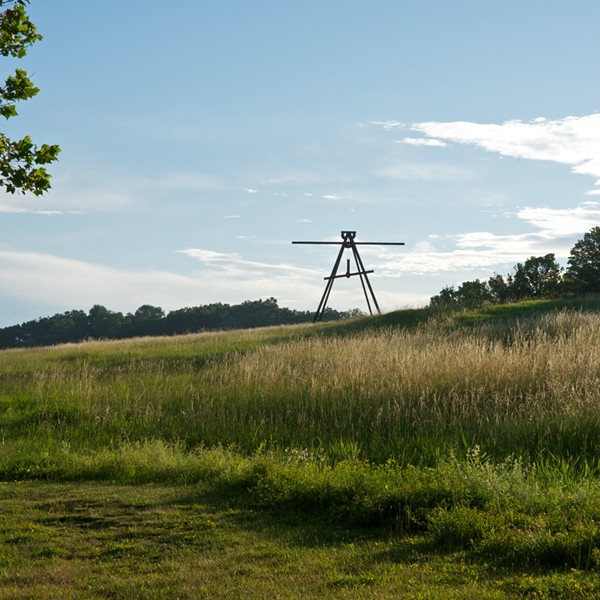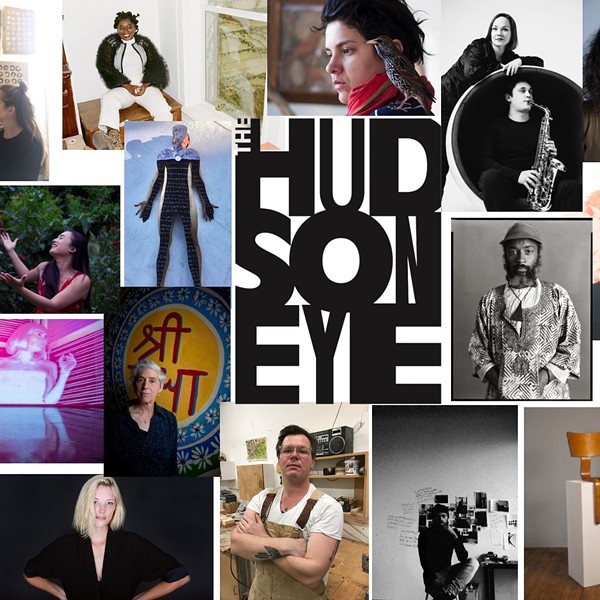Welsh-born sculptor Simon Draper has lived and worked in the US for the last 25 years, a sojourn that began with a student-exchange stint at the Cooper Union in New York. After his moving to the Hudson Valley in 1996, his work in recent years has focused on the humble architecture of the lean-to shed. An endlessly adaptable form, Draper has applied his ingenuity in fashioning them out of surplus and discarded materials—at times, including his own previous work. In an installation at Van Brunt Gallery in Beacon last year, he erected a shed in the middle of the gallery space, fitted out with a small video screen inside that played a recording of the works (also by Draper) hanging on the surrounding walls.
Lest he get too self-reflexive in his shed-building practice (even if brilliantly so), Draper has most recently developed the Habitat for Artists project, which debuted this summer with a cluster of sheds adjacent to the parking lot of Spire Studios in Beacon. Reaching out to include nearly a dozen other artists, the questions raised here are pretty profound—in a time of escalating prices for artists’ workspaces (and when those who’ve been priced out of Manhattan and Brooklyn have arrived in the Hudson Valley in droves), just how much space does an artist need to create his or her work?
On September 9, from 6 to 9pm, there will be a CD release party for Dar Williams (who’s been working in one of the Habitat sheds) on the site at Spire Studios in Beacon. www.habitatforartists.blogspot.com.
On September 27, Habitat for Artists will be appearing at the second annual Celebration of the Arts (COTA) in Hasbrouck Park in New Paltz. www.celebrationofthearts.net.
SIMON DRAPER ON HIS WORK
Art and mortality
When I was young, people around me kept saying, “You have a good hand” or “You have a good color sense” or even just “You’re very observant.” I was looking into being a draughtsman, and I started to notice that people called artists were actually doing more interesting things. I think it was more stumbling upon it. Then when I was 15, I got run over by a car, and as my mother always said, “You haven’t been the same since.” When you’re looking as a kid into the grille of a big car, things alter drastically, because you’re one step away from the grave, and it’s not where you intended to be. At the time, my mind was going on about my physics homework, and all this other stuff, and suddenly, I was waking up in the middle of the road. There was this traumatic experience of not being able to walk for a period of time, being in a hospital, and not going back to school for a long time. You realize that everyone was in this other world, and I’d been taken out of it. Suddenly, it was almost an analogy of where the artist finds themselves on the periphery of society and culture, looking in and commenting upon it. Looking back, having this altered state, I started to look at things very differently.
When I lived in New York, working out of makeshift studios in various spaces, my most creative space was located in a basement next door to the Brooklyn Casket Company. As a sideline, I was making crates for art shipping. So I’d put these things out on the sidewalk, where they’d be picked up later in the day, and then next door you’d see these wooden pine boxes that were being built, and people would come along and ask if my crates were the bargain-basement versions (some of them were quite large). I was given the space for next to nothing, but the paradox was that I actually spent more time down there because it was so affordable.
Gone fishin’
My wife’s mother is a painter, and once, many years ago, she received a call from the police notifying her to bring her fishing house in from the lake. She said, “What are you talking about?” They told her that her name was on the side of this shack, and she realized that she’d thrown away a whole slew of paintings at the dump, and somebody had obviously commandeered them to make a fishing house. When I heard about this, five or six years ago, I imagined the paintings, on Masonite or plywood panel, being recycled into simple shelters for this other activity that people were passionate about in Minnesota. At that point, I thought it would be wonderful if all art could be that meaningful to people, even if it was just building material. But it’s also just recontextualizing, taking something with high aspirations back to its roots and becoming simply building material again.
Location, location, location
The Hudson Valley has become, over the last decade or so that I’ve been living here, a very different place. Beacon, when I first arrived, was the usual depressed, postindustrial river town that depended on manufacturing that had since moved to China or wherever, and the [people there] were finding new ways to support themselves, having to travel to New York, or be involved in local service industries. It wasn’t the place it is now (not that it’s a raging metropolis). The fact that Dia just celebrated its fifth birthday—not that it ordains the activity of artmaking in Beacon—but the fact that it is in close proximity drew a lot of artists who have found it hard to exist in the city, especially since 9/11.
Part of being an artist is being able to see the jewel in the rough, but at the same time you’re doing that, you’re changing the market and putting a quantifiable value, making a commodity out of something that was just a rundown place. You see this redefinition of space. A real estate person told me the other day that they heard from a couple of speculators from elsewhere in the country that the thing to do was to follow the artists. So he’s now in Beacon trying to buy up property because the artists have moved up here. The artists sometimes unwittingly play this role of sanctioning the gentrification.
I like the shed form because it happens off the grid [of all this real estate speculation]. Different towns have different building codes concerning outbuildings, also often defining their specific usage. So [with the Habitat project] I’m taking an architectural form that has a myriad of uses, and we’ll start to inhabit these as work spaces, small enough to slide under the radar of permitting processes, and also realizing that perhaps you don’t need such a big space to actually create work. Am I a more serious artist because I have this commitment to space, to having a huge studio, or am I more of a person because I live in a 6,000-square-foot McMansion somewhere? That’s an interesting value system, but it’s not one I want to subscribe to. What if you had a space you could change, and adapt, and be fluid with, and it doesn’t take you seven days of work to pay for?
Beyond commodity to community
In art school, we read Chipp’s Theories of Modern Art, with all these quotes from famous modern artists. We actually strove to misunderstand or recontextualize what was said in that. It seemed almost like everybody else had this pre-ordained understanding of what they were doing, so be careful what you say because it can either be taken out of context, or suddenly it’s like, “Wow, he’s not an idiot, he’s profound—or is he profoundly an idiot?” I always thought that book was hard to get your head around—it’s not until you’ve gotten into the driving seat, and experienced [making art] that you can get it. For most of us, it’s really hard to put into a clear context, so it’s words in an altered state. People don’t realize when they’re looking at a piece of art that the artist is, for the most part, supported by a community. There are very few people who are alone up in the garret. There’s a whole other social reality that gets left out when people focus on that moment of isolation, being hit by the arrow of creativity. Having relevance as an artist within your own community is, I think, the next step for revitalizing art as a valid thing to do, something valuable, but not a commodity. For me, it’s been, not a struggle, but a kind of quest to forge strong links to the community that I live in. The local hardware store now rings me up to say “We’ve got a gallon of paint that’s the wrong color—can you use it? Because we’re going to throw it away.” Stuff like that is important now, especially working as an artist in this fuel-thieved economy. Working a little more consciously in light of materials—not putting a further burden on things—is going to be important.
